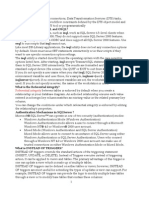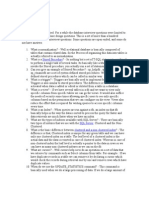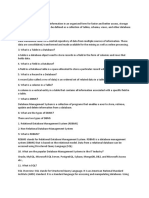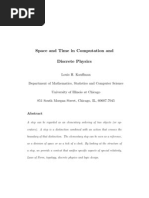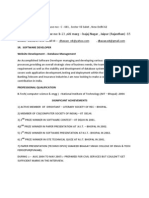SQL Interview Question &answer: Null Null
Uploaded by
mohini tripathiSQL Interview Question &answer: Null Null
Uploaded by
mohini tripathiSQL Interview Question &Answer 2011
What is Sql?
SQL (pronounced "ess-que-el") stands for Structured Query Language. SQL is used to communicate with
a database. According to ANSI (American National Standards Institute), it is the standard language for
relational database management systems. SQL statements are used to perform tasks such as update data
on a database, or retrieve data from a database. Some common relational database management systems
that use SQL are: Oracle, Sybase, Microsoft SQL Server, Access, Ingres, etc. Although most database
systems use SQL, most of them also have their own additional proprietary extensions that are usually only
used on their system. However, the standard SQL commands such as "Select", "Insert", "Update",
"Delete", "Create", and "Drop" can be used to accomplish almost everything that one needs to do with a
database. This tutorial will provide you with the instruction on the basics of each of these commands as
well as allow you to put them to practice using the SQL Interpreter.
What is normalization? Explain different levels of normalization?
Check out the article Q100139 from Microsoft knowledge base and of course, there's much more
information available in the net. It will be a good idea to get a hold of any RDBMS fundamentals
text book, especially the one by C. J. Date. Most of the times, it will be okay if you can explain
till third normal form.
What is de-normalization and when would you go for it?
As the name indicates, de-normalization is the reverse process of normalization. It is the
controlled introduction of redundancy in to the database design. It helps improve the query
performance as the number of joins could be reduced.
How do you implement one-to-one, one-to-many and many-to-many relationships while
designing tables?
One-to-One relationship can be implemented as a single table and rarely as two tables with
primary and foreign key relationships. One-to-Many relationships are implemented by splitting
the data into two tables with primary key and foreign key relationships. Many-to-Many
relationships are implemented using a junction table with the keys from both the tables forming
the composite primary key of the junction table.
It will be a good idea to read up a database designing fundamentals text book.
What's the difference between a primary key and a unique key?
Both primary key and unique enforce uniqueness of the column on which they are defined. But
by default primary key creates a clustered index on the column, where are unique creates a non-
clustered index by default. Another major difference is that, primary key does not allow NULLs,
but unique key allows one NULL only.
What are user defined data types and when you should go for them?
1 Shwetank K Gupta +91-9815144280
shwetankkg@gmail.com
SQL Interview Question &Answer 2011
User defined data types let you extend the base SQL Server data types by providing a descriptive
name, and format to the database. Take for example, in your database, there is a column called
Flight_Num which appears in many tables. In all these tables it should be varchar(8). In this
case you could create a user defined data type called Flight_num_type of varchar(8) and use
it across all your tables.
See sp_addtype, sp_droptype in books online.
What is bit data type and what's the information that can be stored inside a bit column?
Bit data type is used to store Boolean information like 1 or 0 ( true or false). Until SQL Server
6.5 bit data type could hold either a 1 or 0 and there was no support for NULL. But from SQL
Server 7.0 onwards, bit data type can represent a third state, which is NULL.
Define candidate key, alternate key, composite key.
A candidate key is one that can identify each row of a table uniquely. Generally a candidate
key becomes the primary key of the table. If the table has more than one candidate key, one of
them will become the primary key, and the rest are called alternate keys.
A key formed by combining at least two or more columns is called composite key.
What are defaults? Is there a column to which a default cannot be bound?
A default is a value that will be used by a column, if no value is supplied to that column while
inserting data. IDENTITY columns and timestamp columns can't have defaults bound to them. See
CREATE DEFAULT in books online.
What is a transaction and what are ACID properties?
A transaction is a logical unit of work in which, all the steps must be performed or none. ACID
stands for Atomicity, Consistency, Isolation, Durability. These are the properties of a transaction.
For more information and explanation of these properties, see SQL Server books online or any
RDBMS fundamentals text book.
Explain different isolation levels
An isolation level determines the degree of isolation of data between concurrent transactions.
The default SQL Server isolation level is Read Committed. Here are the other isolation levels (in
the ascending order of isolation): Read Uncommitted, Read Committed, Repeatable Read,
Serializable. See SQL Server books online for an explanation of the isolation levels. Be sure to
read about SET TRANSACTION ISOLATION LEVEL, which lets you customize the isolation level at
the connection level.
2 Shwetank K Gupta +91-9815144280
shwetankkg@gmail.com
SQL Interview Question &Answer 2011
CREATE INDEX myIndex ON myTable (myColumn)
What type of Index will get created after executing the above statement?
Non-clustered index. Important thing to note: By default a clustered index gets created on the
primary key, unless specified otherwise.
What is the maximum size of a row?8060 bytes. Do not be surprised with questions like 'What
is the maximum number of columns per table'. Check out SQL Server books online for the page
titled: "Maximum Capacity Specifications".
Explain Active/Active and Active/Passive cluster configurations
Hopefully you have experience setting up cluster servers. But if you do not, at least be familiar
with the way clustering works and the two clustering configurations Active/Active and
Active/Passive. SQL Server books online has enough information on this topic and there is a
good white paper available on Microsoft site.
Explain the architecture of SQL Server
This is a very important question and you better be able to answer it if consider yourself a DBA.
SQL Server books online is the best place to read about SQL Server architecture. Read up the
chapter dedicated to SQL Server Architecture.
What is Lock Escalation?
Lock escalation is the process of converting a lot of low level locks (like row locks, page locks)
into higher level locks (like table locks). Every lock is a memory structure too many locks would
mean, more memory being occupied by locks. To prevent this from happening, SQL Server
escalates the many fine-grain locks to fewer coarse-grain locks. Lock escalation threshold was
definable in SQL Server 6.5, but from SQL Server 7.0 onwards it's dynamically managed by
SQL Server.
What's the difference between DELETE TABLE and TRUNCATE TABLE commands?
DELETE TABLE is a logged operation, so the deletion of each row gets logged in the transaction
log, which makes it slow. TRUNCATE TABLE also deletes all the rows in a table, but it will not log
the deletion of each row, instead it logs the de-allocation of the data pages of the table, which
makes it faster. Of course, TRUNCATE TABLE can be rolled back.
Explain the storage models of OLAP
Check out MOLAP, ROLAP and HOLAP in SQL Server books online for more information.
3 Shwetank K Gupta +91-9815144280
shwetankkg@gmail.com
SQL Interview Question &Answer 2011
What are the new features introduced in SQL Server 2000 (or the latest release of SQL Server at
the time of your interview)? What changed between the previous version of SQL Server and the
current version?
This question is generally asked to see how current is your knowledge. Generally there is a
section in the beginning of the books online titled "What's New", which has all such information.
Of course, reading just that is not enough, you should have tried those things to better answer the
questions. Also check out the section titled "Backward Compatibility" in books online which
talks about the changes that have taken place in the new version.
What are constraints? Explain different types of constraints.
Constraints enable the RDBMS enforce the integrity of the database automatically, without
needing you to create triggers, rule or defaults.
Types of constraints: NOT NULL, CHECK, UNIQUE, PRIMARY KEY, FOREIGN KEY
For an explanation of these constraints see books online for the pages titled: " Constraints" and
"CREATE TABLE", "ALTER TABLE"
What is an index? What are the types of indexes? How many clustered indexes can be
created on a table? I create a separate index on each column of a table. what are the
advantages and disadvantages of this approach?
Indexes in SQL Server are similar to the indexes in books. They help SQL Server retrieve the
data quicker.
Indexes are of two types. Clustered indexes and non-clustered indexes. When you create a
clustered index on a table, all the rows in the table are stored in the order of the clustered index
key. So, there can be only one clustered index per table. Non-clustered indexes have their own
storage separate from the table data storage. Non-clustered indexes are stored as B-tree structures
(so do clustered indexes), with the leaf level nodes having the index key and it's row locater. The
row located could be the RID or the Clustered index key, depending up on the absence or
presence of clustered index on the table.
If you create an index on each column of a table, it improves the query performance, as the query
optimizer can choose from all the existing indexes to come up with an efficient execution plan.
At the same time, data modification operations (such as INSERT, UPDATE, DELETE) will become
slow, as every time data changes in the table, all the indexes need to be updated. Another
disadvantage is that, indexes need disk space, the more indexes you have, more disk space is
used.
What is RAID and what are different types of RAID configurations?
4 Shwetank K Gupta +91-9815144280
shwetankkg@gmail.com
SQL Interview Question &Answer 2011
RAID stands for Redundant Array of Inexpensive Disks, used to provide fault tolerance to
database servers. There are six RAID levels 0 through 5 offering different levels of performance,
fault tolerance. MSDN has some information about RAID levels and for detailed information,
check out the RAID advisory board's homepage
What are the steps you will take to improve performance of a poor performing query?
This is a very open ended question and there could be a lot of reasons behind the poor
performance of a query. But some general issues that you could talk about would be: No indexes,
table scans, missing or out of date statistics, blocking, excess recompilations of stored
procedures, procedures and triggers without SET NOCOUNT ON, poorly written query with
unnecessarily complicated joins, too much normalization, excess usage of cursors and temporary
tables.
Some of the tools/ways that help you troubleshooting performance problems are:
SET SHOWPLAN_ALL ON,
SET SHOWPLAN_TEXT ON,
SET STATISTICS IO ON,
SQL Server Profiler,
Windows NT /2000 Performance monitor,
Graphical execution plan in Query Analyzer.
Download the white paper on performance tuning SQL Server from Microsoft web site.
What are the steps you will take, if you are tasked with securing an SQL Server?
Again this is another open ended question. Here are some things you could talk about: Preferring
NT authentication, using server, database and application roles to control access to the data,
securing the physical database files using NTFS permissions, using an unguessable SA password,
restricting physical access to the SQL Server, renaming the Administrator account on the SQL
Server computer, disabling the Guest account, enabling auditing, using multi-protocol
encryption, setting up SSL, setting up firewalls, isolating SQL Server from the web server etc.
Read the white paper on SQL Server security from Microsoft website. Also check out My SQL
Server security best practices
What is a deadlock and what is a live lock? How will you go about resolving deadlocks?
Deadlock is a situation when two processes, each having a lock on one piece of data, attempt to
acquire a lock on the other's piece. Each process would wait indefinitely for the other to release
the lock, unless one of the user processes is terminated. SQL Server detects deadlocks and
terminates one user's process.
5 Shwetank K Gupta +91-9815144280
shwetankkg@gmail.com
SQL Interview Question &Answer 2011
A livelock is one, where a request for an exclusive lock is repeatedly denied because a series of
overlapping shared locks keeps interfering. SQL Server detects the situation after four denials
and refuses further shared locks. A livelock also occurs when read transactions monopolize a
table or page, forcing a write transaction to wait indefinitely.
Check out SET DEADLOCK_PRIORITY and "Minimizing Deadlocks" in SQL Server books
online. Also check out the article Q169960 from Microsoft knowledge base.
What is blocking and how would you troubleshoot it?
Blocking happens when one connection from an application holds a lock and a second
connection requires a conflicting lock type. This forces the second connection to wait, blocked
on the first.
Read up the following topics in SQL Server books online: Understanding and avoiding blocking,
Coding efficient transactions.
Explain CREATE DATABASE syntax
Many of us are used to creating databases from the Enterprise Manager or by just issuing the
command:
CREATE DATABASE MyDB.
But what if you have to create a database with two file groups, one on drive C and the other on
drive D with log on drive E with an initial size of 600 MB and with a growth factor of 15%?
That's why being a DBA you should be familiar with the CREATE DATABASE syntax. Check out
SQL Server books online for more information.
How to restart SQL Server in single user mode? How to start SQL Server in minimal
configuration mode?
SQL Server can be started from command line, using the SQLSERVR.EXE. This EXE has some
very important parameters with which a DBA should be familiar with. -m is used for starting
SQL Server in single user mode and -f is used to start the SQL Server in minimal configuration
mode. Check out SQL Server books online for more parameters and their explanations.
As a part of your job, what are the DBCC commands that you commonly use for database
maintenance?
DBCC CHECKDB,
DBCC CHECKTABLE,
DBCC CHECKCATALOG,
DBCC CHECKALLOC,
DBCC SHOWCONTIG,
6 Shwetank K Gupta +91-9815144280
shwetankkg@gmail.com
SQL Interview Question &Answer 2011
DBCC SHRINKDATABASE,
DBCC SHRINKFILE etc.
But there are a whole load of DBCC commands which are very useful for DBAs. Check out SQL
Server books online for more information.
What are statistics, under what circumstances they go out of date, how do you update
them?
Statistics determine the selectivity of the indexes. If an indexed column has unique values then
the selectivity of that index is more, as opposed to an index with non-unique values. Query
optimizer uses these indexes in determining whether to choose an index or not while executing a
query.
Some situations under which you should update statistics:
1. If there is significant change in the key values in the index
2. If a large amount of data in an indexed column has been added, changed, or removed
(that is, if the distribution of key values has changed), or the table has been truncated
using the TRUNCATE TABLE statement and then repopulated
3. Database is upgraded from a previous version
Look up SQL Server books online for the following commands:
UPDATE STATISTICS,
STATS_DATE,
DBCC SHOW_STATISTICS,
CREATE STATISTICS,
DROP STATISTICS,
sp_autostats,
sp_createstats,
sp_updatestats
What are the different ways of moving data/databases between servers and databases in
SQL Server?
There are lots of options available, you have to choose your option depending upon your
requirements. Some of the options you have are:
BACKUP/RESTORE,
Detaching and attaching databases,
Replication,
DTS,
BCP,
logshipping,
7 Shwetank K Gupta +91-9815144280
shwetankkg@gmail.com
SQL Interview Question &Answer 2011
INSERT...SELECT, SELECT...INTO,
creating INSERT scripts to generate data.
Explain different types of BACKUPs available in SQL Server? Given a particular scenario,
how would you go about choosing a backup plan?
Types of backups you can create in SQL Sever 7.0+ are Full database backup, differential
database backup, transaction log backup, filegroup backup. Check out the BACKUP and RESTORE
commands in SQL Server books online. Be prepared to write the commands in your interview.
Books online also has information on detailed backup/restore architecture and when one should
go for a particular kind of backup.
What is database replication? What are the different types of replication you can set up in
SQL Server?
Replication is the process of copying/moving data between databases on the same or different
servers. SQL Server supports the following types of replication scenarios:
* Snapshot replication
* Transactional replication (with immediate updating subscribers, with queued updating
subscribers)
* Merge replication
See SQL Server books online for in-depth coverage on replication. Be prepared to explain how
different replication agents function, what are the main system tables used in replication etc.
How to determine the service pack currently installed on SQL Server?
The global variable @@Version stores the build number of the sqlservr.exe, which is used to
determine the service pack installed. To know more about this process visit SQL Server service
packs and versions.
What are cursors? Explain different types of cursors. What are the disadvantages of
cursors? How can you avoid cursors?
Cursors allow row-by-row processing of the resultsets.
Types of cursors:
Static,
Dynamic,
Forward-only,
Keyset-driven.
See books online for more information.
8 Shwetank K Gupta +91-9815144280
shwetankkg@gmail.com
SQL Interview Question &Answer 2011
Disadvantages of cursors: Each time you fetch a row from the cursor, it results in a network
roundtrip, where as a normal SELECT query makes only one round trip, however large the
resultset is. Cursors are also costly because they require more resources and temporary storage
(results in more IO operations). Further, there are restrictions on the SELECT statements that can
be used with some types of cursors.
Most of the times, set based operations can be used instead of cursors. Here is an example:
If you have to give a flat hike to your employees using the following criteria:
Salary between 30000 and 40000 -- 5000 hike
Salary between 40000 and 55000 -- 7000 hike
Salary between 55000 and 65000 -- 9000 hike
In this situation many developers tend to use a cursor, determine each employee's salary and
update his salary according to the above formula. But the same can be achieved by multiple
update statements or can be combined in a single UPDATE statement as shown below:
UPDATE tbl_emp SET salary =
CASE WHEN salary BETWEEN 30000 AND 40000 THEN salary + 5000
WHEN salary BETWEEN 40000 AND 55000 THEN salary + 7000
WHEN salary BETWEEN 55000 AND 65000 THEN salary + 10000
END
Another situation in which developers tend to use cursors: You need to call a stored procedure
when a column in a particular row meets certain condition. You don't have to use cursors for this.
This can be achieved using WHILE loop, as long as there is a unique key to identify each row.
Write down the general syntax for a SELECT statements covering all the options.
Here's the basic syntax: (Also checkout SELECT in books online for advanced syntax).
SELECT select_list
[INTO new_table_]
FROM table_source
[WHERE search_condition]
9 Shwetank K Gupta +91-9815144280
shwetankkg@gmail.com
SQL Interview Question &Answer 2011
[GROUP BY group_by__expression]
[HAVING search_condition]
[ORDER BY order__expression [ASC | DESC] ]
What is a join and explain different types of joins?
Joins are used in queries to explain how different tables are related. Joins also let you select data
from a table depending upon data from another table.
Types of joins:
INNER JOINs,
OUTER JOINs,
CROSS JOINs
OUTER JOINs are further classified as
LEFT OUTER JOINS,
RIGHT OUTER JOINS and
FULL OUTER JOINS.
For more information see pages from books online titled: "Join Fundamentals" and "Using
Joins".
Can you have a nested transaction?
Yes, very much. Check out BEGIN TRAN, COMMIT, ROLLBACK, SAVE TRAN and @@TRANCOUNT
What is an extended stored procedure? Can you instantiate a COM object by using T-
SQL?
An extended stored procedure is a function within a DLL (written in a programming language
like C, C++ using Open Data Services (ODS) API) that can be called from T-SQL, just the way
we call normal stored procedures using the EXEC statement. See books online to learn how to
create extended stored procedures and how to add them to SQL Server.
10 Shwetank K Gupta +91-9815144280
shwetankkg@gmail.com
SQL Interview Question &Answer 2011
Yes, you can instantiate a COM (written in languages like VB, VC++) object from T-SQL by
using sp_OACreate stored procedure.
Also see books online for sp_OAMethod, sp_OAGetProperty, sp_OASetProperty,
sp_OADestroy.
What is the system function to get the current user's user id?
USER_ID(). Also check out other system functions like
USER_NAME(),
SYSTEM_USER,
SESSION_USER,
CURRENT_USER,
USER,
SUSER_SID(),
HOST_NAME().
What are triggers? How many triggers you can have on a table? How to invoke a trigger on
demand?
Triggers are special kind of stored procedures that get executed automatically when an INSERT,
UPDATE or DELETE operation takes place on a table.
In SQL Server 6.5 you could define only 3 triggers per table, one for INSERT, one for UPDATE
and one for DELETE. From SQL Server 7.0 onwards, this restriction is gone, and you could create
multiple triggers per each action. But in 7.0 there's no way to control the order in which the
triggers fire. In SQL Server 2000 you could specify which trigger fires first or fires last using
sp_settriggerorder
Triggers cannot be invoked on demand. They get triggered only when an associated action
(INSERT, UPDATE, DELETE) happens on the table on which they are defined.
Triggers are generally used to implement business rules, auditing. Triggers can also be used to
extend the referential integrity checks, but wherever possible, use constraints for this purpose,
instead of triggers, as constraints are much faster.
11 Shwetank K Gupta +91-9815144280
shwetankkg@gmail.com
SQL Interview Question &Answer 2011
Till SQL Server 7.0, triggers fire only after the data modification operation happens. So in a way,
they are called post triggers. But in SQL Server 2000 you could create pre triggers also. Search
SQL Server 2000 books online for INSTEAD OF triggers.
Also check out books online for 'inserted table', 'deleted table' and COLUMNS_UPDATED()
There is a trigger defined for INSERT operations on a table, in an OLTP system. The trigger is
written to instantiate a COM object and pass the newly inserted rows to it for some custom
processing.
What do you think of this implementation? Can this be implemented better?
Instantiating COM objects is a time consuming process and since you are doing it from within a
trigger, it slows down the data insertion process. Same is the case with sending emails from
triggers. This scenario can be better implemented by logging all the necessary data into a
separate table, and have a job which periodically checks this table and does the needful.
12 Shwetank K Gupta +91-9815144280
shwetankkg@gmail.com
You might also like
- Apache Cassandra Administrator Associate - Exam Practice TestsFrom EverandApache Cassandra Administrator Associate - Exam Practice TestsNo ratings yet
- BASIC SQL Server Interview Questions With Answers PDFNo ratings yetBASIC SQL Server Interview Questions With Answers PDF7 pages
- Ssas Real Time Interview Questions and AnswersNo ratings yetSsas Real Time Interview Questions and Answers7 pages
- IBM - SQL DBA Interview Questions - SQL DBA Interview Questions100% (1)IBM - SQL DBA Interview Questions - SQL DBA Interview Questions2 pages
- SQL Server 2008/2012: Database Administrator Class 1No ratings yetSQL Server 2008/2012: Database Administrator Class 169 pages
- SQL Server Interview Questions and AnswersNo ratings yetSQL Server Interview Questions and Answers2 pages
- DBMS - JS in Database Management Systems With Its Operations and Its FunctionalitiesNo ratings yetDBMS - JS in Database Management Systems With Its Operations and Its Functionalities71 pages
- Create Int Varchar Date Varchar State Varchar: Emp - Piyush Employeeid Empname 30 Dob City 20 20100% (1)Create Int Varchar Date Varchar State Varchar: Emp - Piyush Employeeid Empname 30 Dob City 20 2010 pages
- Personal: 1. What DBA Activities Did You To Do Today?No ratings yetPersonal: 1. What DBA Activities Did You To Do Today?7 pages
- 70-764 - Administering A SQL Database InfrastructureNo ratings yet70-764 - Administering A SQL Database Infrastructure8 pages
- Top Power BI Interview Questions and Answers For 2022No ratings yetTop Power BI Interview Questions and Answers For 202219 pages
- SSIS Design Pattern - Incremental Loads: Andy LeonardNo ratings yetSSIS Design Pattern - Incremental Loads: Andy Leonard55 pages
- Explain How To Create A New Database: Smallfile Case INo ratings yetExplain How To Create A New Database: Smallfile Case I6 pages
- Microsoft SQL Server Interview Questions and Answers100% (3)Microsoft SQL Server Interview Questions and Answers28 pages
- HTTP://WWW - Sioug.si/predavanja/97/platinum/sld012.htm : 1.what Is An Oracle Instance?100% (1)HTTP://WWW - Sioug.si/predavanja/97/platinum/sld012.htm : 1.what Is An Oracle Instance?6 pages
- Oracle Database Mastery: Comprehensive Techniques for Advanced ApplicationFrom EverandOracle Database Mastery: Comprehensive Techniques for Advanced ApplicationNo ratings yet
- High-Performance Oracle: Proven Methods for Achieving Optimum Performance and AvailabilityFrom EverandHigh-Performance Oracle: Proven Methods for Achieving Optimum Performance and AvailabilityNo ratings yet
- Speaking About Numbers:: Case Study: Samsung R&D, Bangalore Hiring ChallengeNo ratings yetSpeaking About Numbers:: Case Study: Samsung R&D, Bangalore Hiring Challenge7 pages
- Mistakes On The Form May Lead To Rejection or Delay in Application ProcessingNo ratings yetMistakes On The Form May Lead To Rejection or Delay in Application Processing7 pages
- Louis H. Kauffman - Space and Time in Computation and Discrete PhysicsNo ratings yetLouis H. Kauffman - Space and Time in Computation and Discrete Physics50 pages
- Delivered Wednesday 12/06/2019 at 14:42: Ship Track Manage My Account Customs Tools LearnNo ratings yetDelivered Wednesday 12/06/2019 at 14:42: Ship Track Manage My Account Customs Tools Learn2 pages
- Inspector General For Registration (IGR) : User Manual For Online EC ApplicationNo ratings yetInspector General For Registration (IGR) : User Manual For Online EC Application11 pages
- Install GlassFish With JDK 7 On CentOS, RHEL, Fedora, Debian, UbuntuNo ratings yetInstall GlassFish With JDK 7 On CentOS, RHEL, Fedora, Debian, Ubuntu10 pages
- Case Study: Air France Internet MarketingNo ratings yetCase Study: Air France Internet Marketing3 pages
- CS1010E: Programming Methodology: Tutorial 05: Function TBANo ratings yetCS1010E: Programming Methodology: Tutorial 05: Function TBA6 pages
- Axios Systems: Saudi Hollandi Bank ITIL ITSM Case StudyNo ratings yetAxios Systems: Saudi Hollandi Bank ITIL ITSM Case Study2 pages
- Ewan Withers, Senior It Specialist Business Integration, Emea Websphere Lab ServicesNo ratings yetEwan Withers, Senior It Specialist Business Integration, Emea Websphere Lab Services58 pages
- Apache Cassandra Administrator Associate - Exam Practice TestsFrom EverandApache Cassandra Administrator Associate - Exam Practice Tests
- BASIC SQL Server Interview Questions With Answers PDFBASIC SQL Server Interview Questions With Answers PDF
- Interview Questions for DB2 z/OS Application DevelopersFrom EverandInterview Questions for DB2 z/OS Application Developers
- IBM - SQL DBA Interview Questions - SQL DBA Interview QuestionsIBM - SQL DBA Interview Questions - SQL DBA Interview Questions
- SQL Server 2008/2012: Database Administrator Class 1SQL Server 2008/2012: Database Administrator Class 1
- DBMS - JS in Database Management Systems With Its Operations and Its FunctionalitiesDBMS - JS in Database Management Systems With Its Operations and Its Functionalities
- Create Int Varchar Date Varchar State Varchar: Emp - Piyush Employeeid Empname 30 Dob City 20 20Create Int Varchar Date Varchar State Varchar: Emp - Piyush Employeeid Empname 30 Dob City 20 20
- Personal: 1. What DBA Activities Did You To Do Today?Personal: 1. What DBA Activities Did You To Do Today?
- 70-764 - Administering A SQL Database Infrastructure70-764 - Administering A SQL Database Infrastructure
- Top Power BI Interview Questions and Answers For 2022Top Power BI Interview Questions and Answers For 2022
- SSIS Design Pattern - Incremental Loads: Andy LeonardSSIS Design Pattern - Incremental Loads: Andy Leonard
- Explain How To Create A New Database: Smallfile Case IExplain How To Create A New Database: Smallfile Case I
- Microsoft SQL Server Interview Questions and AnswersMicrosoft SQL Server Interview Questions and Answers
- HTTP://WWW - Sioug.si/predavanja/97/platinum/sld012.htm : 1.what Is An Oracle Instance?HTTP://WWW - Sioug.si/predavanja/97/platinum/sld012.htm : 1.what Is An Oracle Instance?
- Oracle Data Guard A Clear and Concise ReferenceFrom EverandOracle Data Guard A Clear and Concise Reference
- Oracle Database Mastery: Comprehensive Techniques for Advanced ApplicationFrom EverandOracle Database Mastery: Comprehensive Techniques for Advanced Application
- High-Performance Oracle: Proven Methods for Achieving Optimum Performance and AvailabilityFrom EverandHigh-Performance Oracle: Proven Methods for Achieving Optimum Performance and Availability
- Oracle SOA BPEL Process Manager 11gR1 A Hands-on TutorialFrom EverandOracle SOA BPEL Process Manager 11gR1 A Hands-on Tutorial
- Microsoft SQL Server 2008 R2 Administration CookbookFrom EverandMicrosoft SQL Server 2008 R2 Administration Cookbook
- Speaking About Numbers:: Case Study: Samsung R&D, Bangalore Hiring ChallengeSpeaking About Numbers:: Case Study: Samsung R&D, Bangalore Hiring Challenge
- Mistakes On The Form May Lead To Rejection or Delay in Application ProcessingMistakes On The Form May Lead To Rejection or Delay in Application Processing
- Louis H. Kauffman - Space and Time in Computation and Discrete PhysicsLouis H. Kauffman - Space and Time in Computation and Discrete Physics
- Delivered Wednesday 12/06/2019 at 14:42: Ship Track Manage My Account Customs Tools LearnDelivered Wednesday 12/06/2019 at 14:42: Ship Track Manage My Account Customs Tools Learn
- Inspector General For Registration (IGR) : User Manual For Online EC ApplicationInspector General For Registration (IGR) : User Manual For Online EC Application
- Install GlassFish With JDK 7 On CentOS, RHEL, Fedora, Debian, UbuntuInstall GlassFish With JDK 7 On CentOS, RHEL, Fedora, Debian, Ubuntu
- CS1010E: Programming Methodology: Tutorial 05: Function TBACS1010E: Programming Methodology: Tutorial 05: Function TBA
- Axios Systems: Saudi Hollandi Bank ITIL ITSM Case StudyAxios Systems: Saudi Hollandi Bank ITIL ITSM Case Study
- Ewan Withers, Senior It Specialist Business Integration, Emea Websphere Lab ServicesEwan Withers, Senior It Specialist Business Integration, Emea Websphere Lab Services



